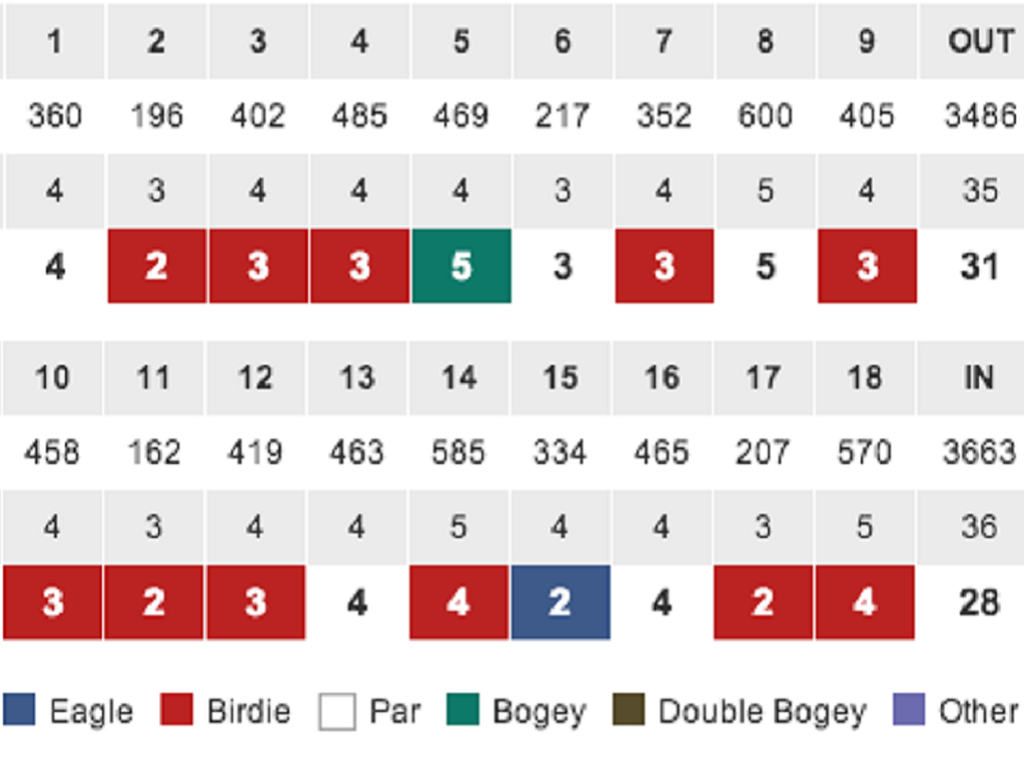News
Is “make more birdies” really the best advice to shoot lower scores?

I often hear golfers say, “I need to make more birdies to shoot lower scores.” This statement has been uttered by the team I currently coach, and through three tournaments this fall, it got me wondering how accurate that statement was for our level of play.
Our players’ scoring averages range from 74 to 87, having played in a minimum of two tournament rounds and up to seven tournament rounds. Most often, I have heard the statement above from our players who are in the middle to higher end of the scoring averages. So, I took a look into our scoring breakdown using the data we collect with GameGolf.
Here are the rankings of birdies per round for the seven players who have traveled this fall
| 1 | 2.7 |
| 2 | 1.42 |
| 3 | 1.17 |
| 4 | 1 |
| 5 | 0.5 |
| 6 | 0.42 |
| 7 | 0.33 |
The difference from the top to the seventh spot is 1.09 birdies per round. The player with the top spot has a scoring average of 74, and the player in seventh spot has a scoring average of 84.67.
Here are the rankings of double bogey/worse for the seven players who have traveled this fall
| 1 | 0.42 |
| 2 | 0.85 |
| 3 | 1 |
| 4 | 1.42 |
| 5 | 2 |
| 6 | 2.5 |
| 7 | 4 |
The difference from the top to the seventh spot is 3.58 doubles/worse per round. Again the player at the top has the 74 scoring average and the player at the bottom has the 87 scoring average.
Diving a little deeper, the players on the team with the top three scoring averages (74, 77.29 and 78) occupy the top three spots in both of these rankings. And taking a look at all the players’ differentials, their rank stays the same compared to their scoring average rank.
The fact that many golfers overlook when making the statement “I need to make more birdies to score better” is that each hole accounts for about 5.5 percent of your round. So, if we take our player who averages one birdie (minus 1) and 2.5 doubles/worse per round (plus 5, conservatively), 5.5 percent of her round is birdies and 13.75 percent of her round is doubles/worse.
If she were to simply focus on making more birdies per round to “balance out” the current 2.5 doubles/worse per round, she would need to increase to five birdies per round. That would be a jump up to 27.5 percent of her round. Compare that to shift a focus to minimizing the doubles/worse category. If this same player could even shave her doubles/worse to 1.5 per round (plus 3, conservatively), it accounts for 8.25 percent of her round.
If we take a look at the top five scoring averages from the LPGA, Women’s DI and Women’s DII we see the scoring averages range from 68 to 72. While the birdies per round range from 2.4 to 4.8. An interesting thing to note from these numbers is that both the low scoring average and best birdies per round do not come from the LPGA players. While difficulty of the course setup may play into this factor, it can highlight that those women who are playing to make a living are making sure that they are keeping their cards clean of the big numbers because they do not have enough holes to make up for those errors with birdies.
While birdies are always more fun to celebrate, in stroke play you are better off to learn how to turn doubles into bogeys and bogeys into pars for better scores.
News
Tour Rundown: Bend, but don’t break

I’m going to gush in this intro paragraph, to get the emo stuff done early. I’ve not pulled harder for a professional to win, than Cameron Young. I coach golf in New York state, and each spring, my best golfers head to a state championship in Poughkeepsie. I first saw Cameron there as a 9th grade student. I saw him three more times after that. I reconnecected with Coach Haas from Wake Forest, an old interview subject from my days on the Old Gold and Black, the Wake newspaper. He was there to watch Cameron. After four years at Wake Forest, Young won on the Korn Ferry Tour, made it to the big tour, almost won two majors, almost won five other events, and finally got the chalice about 25 minutes from the Wake campus. Congratulations, Cameron. You truly are a glass of the finest. #MotherSoDear
OK, let’s move on to the Tour Rundown. The major championship season closed this week in Wales, with the Women’s Open championship. The PGA Tour bounced through Greensboror, N.C., while the PGA Tour Americas hit TO (aka, Toronto) for a long-winded event. The Korn Ferry lads made a stop in Utah, one of just two events for that tour in August. The many-events, golf season is winding down, as we ease from summer toward fall in the northern hemisphere. Let’s bask in the glory of an August sunrise, and run down a quartet of events from the first weekend of the eighth month.
LET/LPGA @ Women’s Open: Miyu bends, but she doesn’t break
Royal Porthcawl was not a known commodity in the major tournament community. The Welsh links had served as host to men’s senior opens, men’s amateurs, and Curtis and Walker Cups in prior years, but never an Open championship for the women or the men. The last-kept secret in UK golf was revealed once again to the world this week, as the best female golfers took to the sandy stage.
Mao Saigo, Grace Kim, Maja Stark, and Minjee Lee hoped to add a second major title to previous wins this season, but only Lee was able to finish inside the top ten. The 2025 playing of the Women’s Open gave us a new-faces gallery from day one. The Kordas and Thitikulls were nowhere to be found, and it was the Mayashitas, Katsus, and Lim Kims that secured the Cymru spotlight. The first round lead was held at 67 by two golfers. One of them battled to the end, while the other posted 81 on day two, and missed the cut. Sitting one shot behind was Miyu Yamashita.
On day two, Yamashita posted the round of the tournament. Her 65 moved her to the front of the aisle, in just her fourth turn around a women’s Open championship. With the pre-event favorites drifting off pace, followers narrowed into two camps: those on the side of an underdog, and others hoping for a weekend charge from back in the pack. In the end, we had a bit of both.
On Saturday, Yamashita bent with 74 on Saturday, offering rays of hope to her pursuing pack. England’s Charley Hull made a run on Sunday closing within one shot before tailing off to a T2 finish with Minami Katsu. Katsu posted the other 65 of the week, on Saturday, but could not overtake her countrywoman, Yamashita. wunderkind Lottie Woad needed one round in the 60s to find her pace, but could only must close-to’s, ending on 284 and a tie with Minjee for eighth.
On Sunday, Yamashita put away the thoughts of Saturday’s struggles, with three-under 33 on the outward half. She closed in plus-one 37, but still won by two, for a first Major and LPGA title.
PGA Tour @ Wyndham: Young gathers first title near home
Cameron Young grew up along the Hudson river, above metro New York, but he also calls Winston-Salem home. He spent four years as a student and athlete at Wake Forest University, then embarked on tour. This week in Greensboro, after a bit of a break, Young opened with 63-62, and revved the engine of Is this the week once more. Runner-up finishes at the Open, the PGA, and a handful of PGA Tour events had followers wonder when the day would come.
On Saturday, Young continued his torrid pace with 65, giving him a five-shot advantage over his closest pursuer. Sunday saw the Scarborough native open with bogey, then reel off five consecutive birdies to remind folks that his time had, at last, arrived. Pars to the 16th, before two harmless bogeys coming home, made Young the 1000th winner of an official PGA Tour event (dating back to before there was a PGA Tour) throughout history. What’s next? I have a suspicion, but I’m not letting on. Mac Meissner closed with 66 to finish solo 2nd, while Mark Hubbard and Alex Noren tied for third.
Korn Ferry Tour @ Utah Championship: Are you Suri it’s Julian?
Who knows exactly when the flower will bloom? Julian Suri played a solid careet at Duke University, then paid his dues on the world’s minor tours for three years. He won twice on two tours in Europe, in 2017. Since then, the grind has continued for the journeyman from New York city. At age 34, Suri broke through in Beehive state, outlasting another grinder (Spencer Levin) and four others, by two shots.
Taylor Montgomery began the week with 62, then posted 64, then 68, and finally, 70. That final round was his undoing. He finished in that second-place tie, two back of the leader. Trace Crowe, Barend Botha, and Kensei Hirata made up the last of the almost quintet. As for Suri, his Sunday play was sublime. His nines were 32 and 31, with his only radar blip a bogey at ten. He closed in style with one final birdie, to double his winning margin. Hogan bloomed late…might Suri?
PGA Tour Americas @ Osprey Valley Open presented by Votorantim Cimentos – CBM Aggregates
Some tournament names run longer than others. This week in Toronto, at the Heathlands course at TPC Toronto, we might have seen the longest tournament title in recorded history. The OVOPBVCCBMA was a splendid affair. It saw three rounds of 62 on Thursday, but of those early risers, only Drew Goodman would stick around until the end. 64 was the low tally on day two, and two of those legionnaires managed to finish inside the top three at week’s end. Saturday brought a 63 from Patrick Newcomb, and he would follow with 64 on Sunday, to finish solo fourth.
Who, then, ended up winning the acronym of the year? It turns out that Carson Bacha had the right stuff in TeeOhhh. Bacha and Jay Card III posted 63 and 64, respectively, on day four, to tie for medalist honors at 23-under 261. Nathan Franks was one shot adrift, despite also closing with 63. If you didn’t go low on Sunday, it was about the check, not the championship.
Bacha and JC3 returned to the 18th hole twice in overtime. Card nearly chipped in from the thick stuff for birdie, while Bacha peeked and shoved a ten-feet attempt at the win. On the second go-round, Card was long with his approach, into the native grasses once more. He was unable to escape, and a routine par from the fairway was enough to earn the former Auburn golfers a first KFT title.
Card III and Bacha both miss their birdie tries on the first playoff hole.
We’ll play 18 again @OspreyOpen. pic.twitter.com/vNpHTdkHDg
— PGA TOUR Americas (@PGATOURAmericas) August 3, 2025
Tour Photo Galleries
Photos from the 2025 Wyndham Championship

GolfWRX is live this week from the final event of the PGA Tour’s regular season, the Wyndham Championship.
Photos are flowing into the forums from Sedgefield Country Club, where we already have a GolfWRX spirit animal Adam Schenk WITB and plenty of putters for your viewing pleasure.
Check out links to all our photos below, which we’ll continue to update as more arrive.

General Albums
- 2025 Wyndham Championship – Tuesday #1
- 2025 Wyndham Championship – Tuesday #2
- 2025 Wyndham Championship – Tuesday #3

WITB Albums
- Chandler Phillips – WITB – 2025 Wyndham Championship
- Davis Riley – WITB – 2025 Wyndham Championship
- Scotty Kennon – WITB – 2025 Wyndham Championship
- Austin Duncan – WITB – 2025 Wyndham Championship
- Will Chandler – WITB – 2025 Wyndham Championship
- Kevin Roy – WITB – 2025 Wyndham Championship
- Ben Griffin – WITB – 2025 Wyndham Championship
- Peter Malnati – WITB – 2025 Wyndham Championship
- Ryan Gerard – WITB – 2025 Wyndham Championship
- Adam Schenk – WITB – 2025 Wyndham Championship
- Kurt Kitayama – WITB – 2025 Wyndham Championship
- Camilo Villegas – WITB – 2025 Wyndham Championship
- Matti Schmid – WITB – 2025 Wyndham Championship
Pullout Albums
- Denny McCarthy’s custom Cameron putters – 2025 Wyndham Championship
- Swag Golf putters – 2025 Wyndham Championship
- Karl Vilips TM MG5 wedges – 2025 Wyndham Championship
- New Bettinardi putters – 2025 Wyndham Championship
- Matt Fitzpatrick’s custom Bettinardi putters – 2025 Wyndham Championship
- Cameron putters – 2025 Wyndham Championship

See what GolfWRXers are saying and join the discussion in the forums.
News
BK’s Breakdowns: Kurt Kitayama’s Winning WITB, 3M Open

Kurt Kitayama just won his 2nd PGA Tour event at the 3M Open. Kurt is a Bridgestone staffer but with just the ball and bag. Here are the rest of the clubs he used to secure a win at the 2025 3M Open.
Driver: Titleist GT3 (11 degrees, D1 SureFit setting)
Shaft: Graphite Design Tour AD VF 7 TX
3-wood: Titleist GT1 3Tour (14.5 degrees, A3 SureFit setting)
Shaft: Graphite Design Tour AD DI 8 TX
7-wood: Titleist GT1 (21 degrees, A1 SureFit setting)
Shaft: Graphite Design Tour AD DI 9 TX
Irons: TaylorMade P7CB (4), TaylorMade P7MB (5-PW)
Shafts: True Temper Dynamic Gold Tour Issue X100
Wedges: Titleist Vokey Design SM10 (52-12F, 56-14F), Vokey Design WedgeWorks (60-K*)
Shafts: True Temper Dynamic Gold Tour Issue S400
Putter: Scotty Cameron Studio Style Newport 2 Tour Prototype
Grip: SuperStroke Zenergy 1.0PT
Grips: Golf Pride Tour Velvet
Ball: Bridgestone Tour B XS (with Mindset)










Jack Nash
Nov 21, 2018 at 12:48 pm
Make more birdies or make fewer mistakes. Like they say “golf is a game of how good your misses are”.
Obee
Nov 21, 2018 at 11:52 am
Great post. Thanks. You MUST be able to make 12 – 16 pars per round on a regular basis to play below scratch golf. And the other 2 to 6 holes should be bogeys or birdies the overwhelming majority of the time.
Simple game when you think of it that way, but the devil is in the details, of course.
WHY do so many otherwise talented, athletic players make so many bogey and doubles?
The answer completely depends on each player. For some, it often starts with poor decision or a poor state of mind. For others, lots of bogeys and doubles are inevitable because they have a pronounced swing flaw(s) that will simply result in very inconsistent ball-striking.
They key is to identify each player’s weaknesses and develop a strategy for that individual player to make MORE pars and fewer doubles (which, consequently, will almost always result in more birdies as well).
Ron
Nov 21, 2018 at 11:37 am
Good article – with numerical support to back it up (esp. since golf is about numbers!)
Speaking of numbers, I’m 78, a low single-digit, and this year have my lowest scoring average ever. How? Several ways. I practice wedges a lot. I play the appropriate tees (~6000 yd courses). But mainly, I’ve learned how to salvage bogeys on holes if I get out of position: Put the ball back in play, try to get within 100 yards of the green, accept getting down in no more than three from there and move on. Not as exciting as cutting the corner of the dogleg or going over the hazard or some other hero shot, but – on average – lowers scores. Do I make a lot of birdies? Occasionally. But I’ve also had birdie free rounds with only three or four bogeys.
Adrian
Nov 21, 2018 at 2:58 am
I am torn by this article because I believe that every golfer as they improve will learn to keep big numbers off the scorecard but there must come a time when you are capable of making your fair share of birdies or your improvement will stall. If you can make birdies in bunches it is a matter of time before you eliminate big numbers. Birdies or better are the only eraser on the scorecard and the better you get at the game the fewer doubles or worse you make and the more birdies or better you will make…hopefully !!
Peter McGill
Nov 21, 2018 at 1:23 am
But if I can turn those triples and doubles into birdies…?
Stephane Barras
Nov 21, 2018 at 12:57 am
Could Erin, the author, give us an answer about Alexdub comments ?
PSG
Nov 20, 2018 at 2:40 pm
This article is kinda nonsensical because it assumes the goal is to shoot the best score possible and not to win the tournament (which are not the same thing).
If -10 wins the tournament, who cares if the college or LPGA player keeps “bogies off the card” and shoots -2? They still lost. Better to shoot +4 at least trying to shoot -10.
The goal of competitive golf isn’t to post the best score you can every round. Its to win the tournament. For a dude who shoots 95 on a Sunday this is pretty good advice. For a dude who is trying to get through Q-School or keep his card this is awful advice, as all that matters is how he does *Relative to the other players*.
If you are trying to make your personal bests (good for you!) then this is right. If you are trying to beat a field (where someone is likely to go very low) then this is wrong.
Taylor
Nov 20, 2018 at 9:37 am
When I tried to turn the corner, I had a guy tell me “give yourself 13-14 birdie putts a round. Pretty much guarantees and even par or better round as long as you stay away from the big numbers
TheCityGame
Nov 20, 2018 at 8:36 am
Any advice that starts with “make more birdies” or “avoid more bogeys” is basically looking at symptoms and not cures. It’s often presented like bogeys and birdies are in opposition to each other. . .as if gunning for birdies on every hole leads a player to too many doubles.
It doesn’t work like that. Players who make more birdies are also players who make fewer bogeys. This is true of amateurs and the pro tour (go look at stats for bogey avoidance and birdie rate. . .it’s almost all the same guys at the top of the list and they’re also the best scorers. https://www.pgatour.com/stats/stat.02414.2018.html and https://www.pgatour.com/stats/stat.156.2018.html)
Advice should be “get better” — whatever that means for an individual player — and when a player “gets better”, she will make more birdies and avoid over-par scores a lot more.
I will agree. . as I’ve gotten better, and more regularly shoot in the low/mid 70’s, the most important thing in scoring is over-par avoidance.
But, that hasn’t come from a strategy of not trying to make birdies. I’m still trying to make birdies all the time. And I make more than I used to. I also avoid big numbers more often.
So, no, “make more birdies” is not really the best advice to shoot lower scores, but neither is “make fewer over-pars”. The best advice to shoot lower scores is be a better golfer (more accurate, longer, better short game, etc.)
Murv
Nov 20, 2018 at 8:30 am
Pretty much stating the obvious for average players.
Duffy McHackster
Nov 19, 2018 at 9:24 pm
Nice to see an article that makes sense to us less skilled types. I manage about a dozen birdies a season, so not at all realistic to expect much improvement there. We can learn to play smarter, manage the course better, and work on the things we can realistically improve. As we get older, we aren’t likely to gain distance, so we need to understand our limitations and and not bite off more than we can chew.
alexdub
Nov 19, 2018 at 10:09 am
Am I missing something? Looking at the first data table concerning average birdies per round, the difference between the first spot (2.7) and the seventh spot (.33) appears to be 2.37 — not the 1.09 stated in the article.
Josh
Nov 19, 2018 at 10:47 am
Think he meant top and second.
Josh
Nov 19, 2018 at 10:48 am
I can’t type. He meant second and seventh.
BL
Nov 19, 2018 at 9:58 am
This is by far the smartest post ever on this site! Well done Erin!